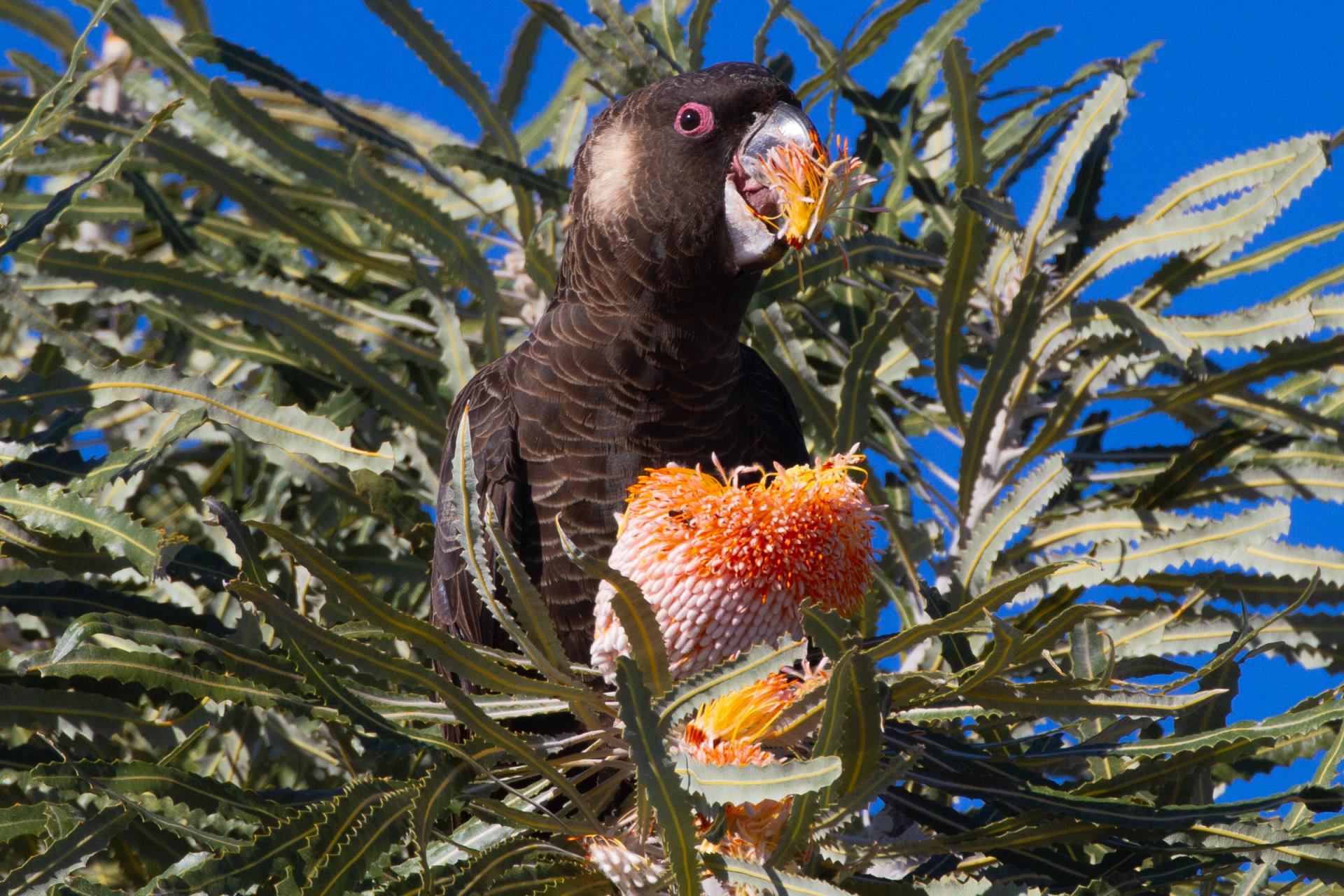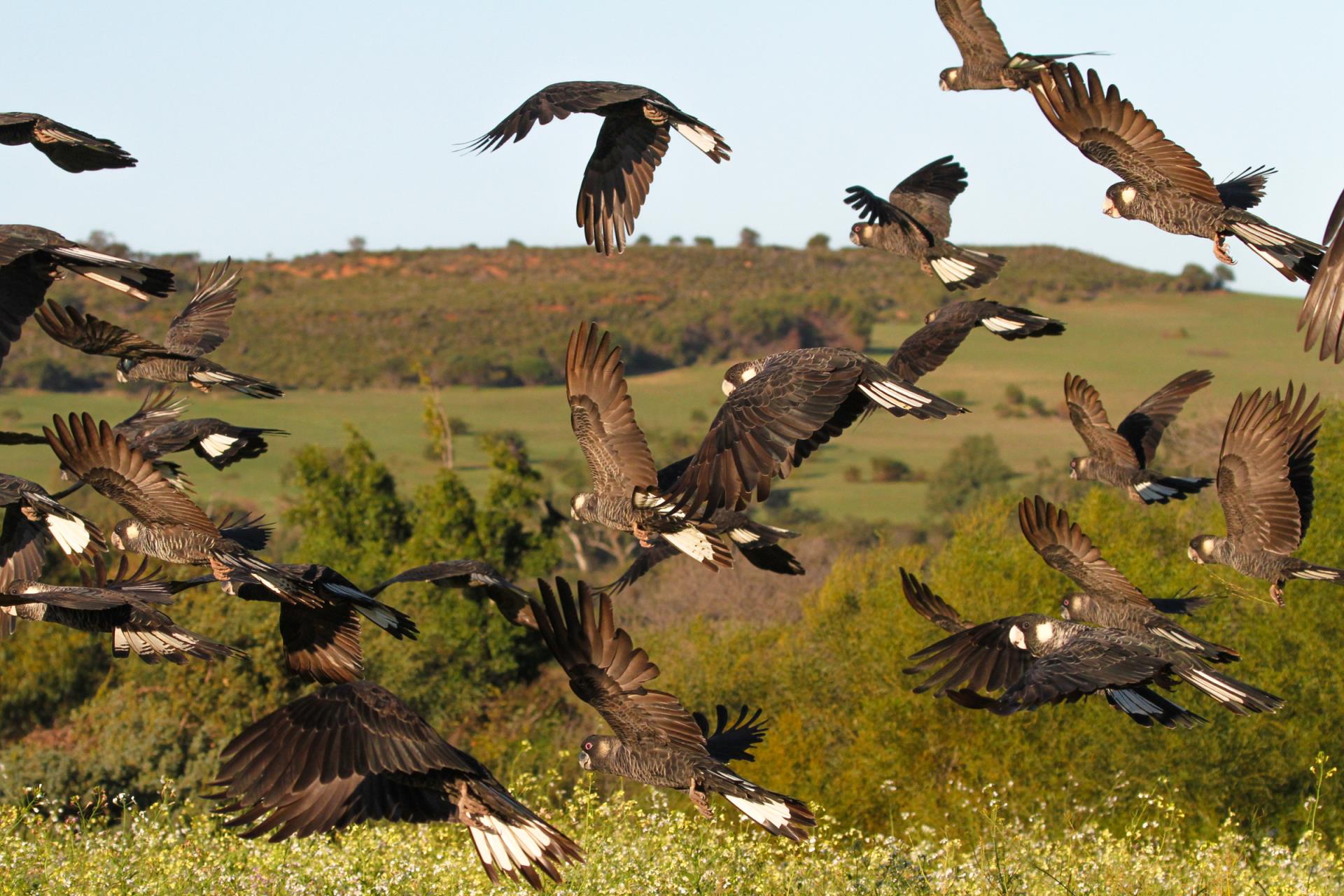Carnaby's Cockatoos

Male feeding: Photo courtesy of Heather Beswick
Information on Carnaby's Cockatoos
Carnaby’s Cockatoo (Zanda latirostris Carnaby) are one of the three endemic species of cockatoo in Western Australia. Once common across the southwest of Western Australia, the species is now listed as endangered under the Commonwealth EPBC Act (1999) meaning that they may become extinct without conservation management. Cockatoos have lost over a third of their former range due to habitat removal and rapid urbanisation across the Perth-Peel region, resulting in a 50% decline in population since the 1960s.
Where Are They Found?
Carnaby’s Cockatoos are found across the Southwest of WA, all the way from Esperance in the Great Southern to Kalbarri in the Midwest and across to the Eastern Wheatbelt areas. They inhabit eucalyptus woodland and are semi-migratory, moving between inland woodland during breeding time and coastal habitat during the non-breeding season (January – June). If you are lucky, you can see Carnaby’s Cockatoos all along the Swan Coastal Plain, and along the mid-west coast.
Diet
Carnaby’s Cockatoos primarily feed on the seeds of locally endemic Eucalypt species such as Marri and Jarrah, and Proteaceae species such as Banksia and Hakea. Due to extensive loss of their primary food sources, Carnaby’s Cockatoos have adapted their feeding habits to consume alternate foods including the seeds and nuts of exotic species such as pine trees, canola seeds, orchard fruits, as well as nectar, flowers and insects. They mainly feed in the tree canopy but will occasionally forage for food on the ground.
Breeding
Carnaby’s Cockatoos mate for life and males go through an elaborate courtship ritual to attract the attention of a female. They nest in tree hollows of old eucalyptus trees which need to be at least 100 years old to form a large enough hollow. The pair will return to the same hollow each year, provided they were successful the previous year, and if the nest is still unoccupied when they return to breed (see below information on competition for hollows). If unsuccessful they will nest in a different hollow in the same area as their previous breeding attempt. Breeding females return to the area they fledged.
If breeding is successful, eggs are laid from June to December with the female usually laying two eggs, on average 8 days apart. The nesting period is around 70 days, with the female incubating the eggs for 28 days. The female rarely leaves the hollow, relying on the male to feed her. Both eggs usually hatch, but the second nestling usually dies within 48 hours of hatching. Where there is sufficient food, some pairs may rear both nestlings, which fledge between 10 and 11 weeks after hatching. The young remain with the flock for the first 12 months or longer,
Breeding pair: Photos courtesy of Heather Beswick.
Interesting Carnaby's facts
- Carnaby’s Cockatoos can live for 25-50 years.
- Nest hollow floors are lined with leaves, twigs, bark, and wood chips females chew from the inside of the hollow.
- Carnaby’s Cockatoos nest in Salmon Gum, Wandoo, Tuart, Flooded Gum, Karri, and Marri.
- Males have a black bill, pink eye ring and a dusky white ear patch. Juvenile males resemble adult females until about three years of age.
- Females have a greyish white bill, grey eye ring and yellowish / white ear patch. The ear patch is the best ID point between male and female birds.
- They are sometimes known as the “rain bird” as they breed in the drier parts of their range, with the timing of egg-laying closely tied to autumn rainfall; the wetter the autumn, the earlier egg-laying commences.
- Carnaby’s Cockatoos are known as “Ngoorlark” in local Noongar language.
- Similar species include the Baudin’s Cockatoo and Forest Red-tailed Cockatoo (see link here)
- Artificial hollows known as “cockatubes” have been successful in providing alternative nest accommodation for breeding pairs, see more information here
Threats to Carnaby's Cockatoos
The main threat to the Carnaby’s Cockatoo is habitat loss and degradation due to urban expansion and intensive clearing for agriculture. Extensive forest clearing of former habitat has led to a reduction in the availability of large trees reducing the availability of nesting hollows. Similarly, loss of foraging habitat has resulted in flocks having to travel further from their home grounds to feed. Cockatoos fly from the hollow for up to 12km to find food, if feeding sites are too distant, then the male will be unable to adequately feed their dependent female and nestling(s), resulting in nestling mortality or leaving the nest underweight. In areas where food sources are scarce this has resulted in populations becoming locally extinct.
The other main threat to Carnaby’s Cockatoo is from native and introduced species that compete for the nest hollows, such as galahs, corellas and bees. Other threats include vehicle strikes and predation of eggs by other species.

Carnaby's over the Chapman Valley: Photo courtesy of Heather Beswick.
What you can do to help black cockatoos
- Protect and conserve large trees that may provide nesting hollows, even old and dead trees can provide habitat for nesting cockatoos.
- Plant local, native shrubs and trees that provide forage for cockatoos.
- Report sightings of pest species such as corellas and honeybees that compete for nest hollows.
- Volunteer at tree planting events, such as “National Tree Day” or at your local nursery (this will help many native species, not just cockies!)
- Consider making a donation to the Kaarakin Black Cockatoo Conservation Centre who are working hard to protect our threatened black cockatoos by rehabilitating injured birds and releasing them back to the wild. blackcockatoorecovery.com
- If you find a sick or injured cockatoo please contact Karrakin Black Cockatoo rescue on (08) 9390 2288 or WA Wildcare Helpline on 08 9474 9055
- Get in touch with NACC (Northern Agricultural Catchment Council) if you have cockatoos on your property.
- Join the Great Cocky Count 2024 here
- Birdlife Midwest-Geraldton is a regional branch of BirdLife WA. Members enjoy bird watching excursions and are active in various citizen science projects as well as community education throughout Midwest Australia. To find out more, or to get involved visit their Facebook page or email birdlifemidwest@gmail.com
Further information and acknowledgements
We would like to thank Heather Beswick- Birdlife Midwest Geraldton, Denis Saunders and Rick Dawson for their valuable input and information.
Australian Government, Department of Climate Change, Energy, Environment and Water. https://www.dcceew.gov.au/environment/biodiversity/threatened/publications/carnabys-black-cockatoo-calyptorhynchus-latirostris
Birdlife Australia, Carnaby’s Black cockatoo. https://birdlife.org.au/bird-profiles/carnabys-black-cockatoo/
Kaarakin Black Cockatoo Centre. https://blackcockatoorecovery.com/cockatoos-and-animals/black-cockatoos/carnabys-cockatoo/